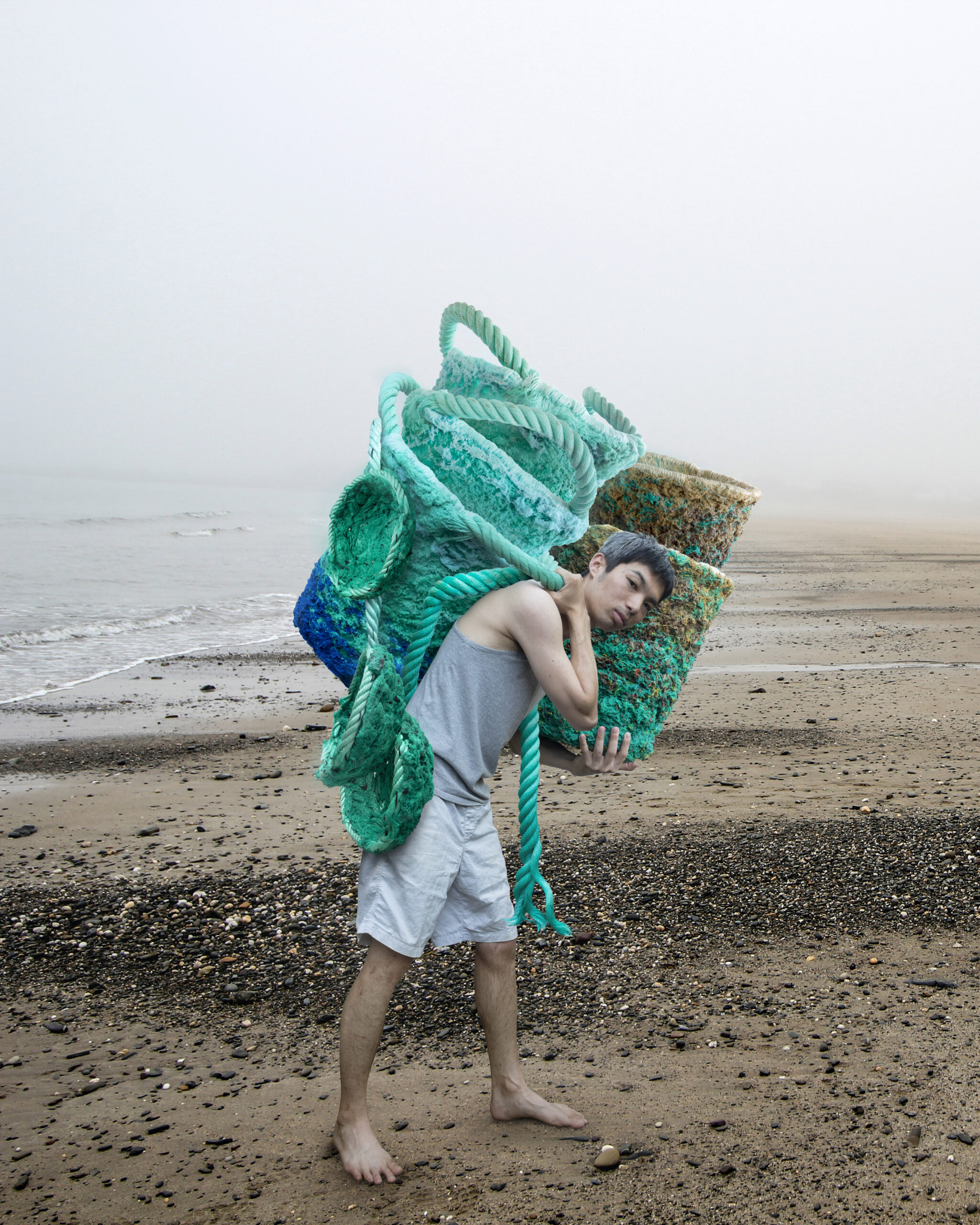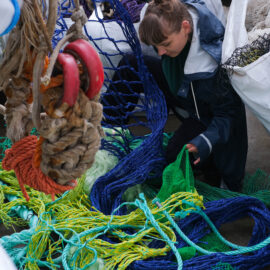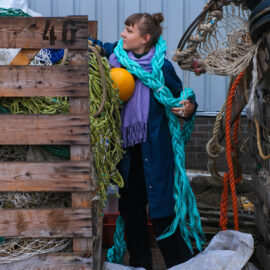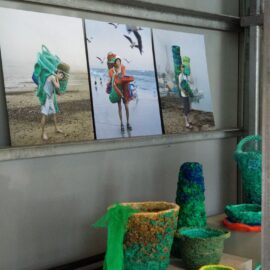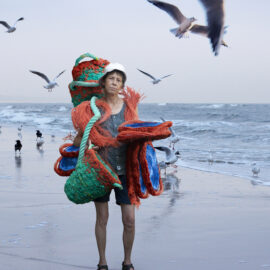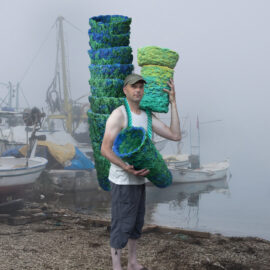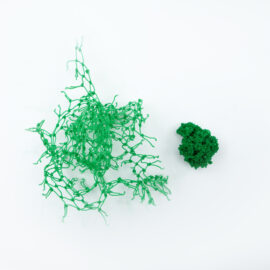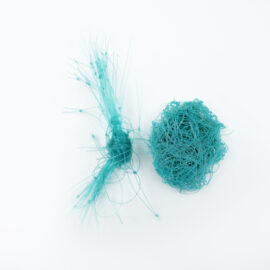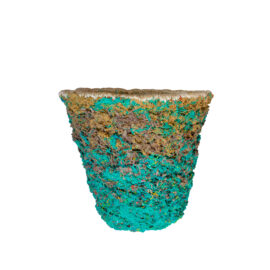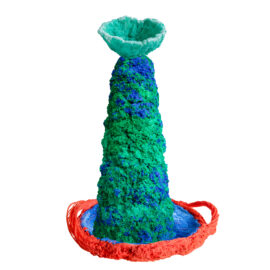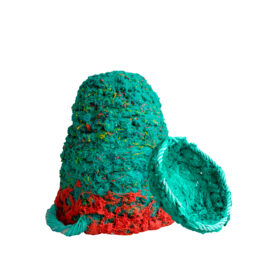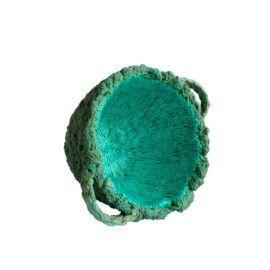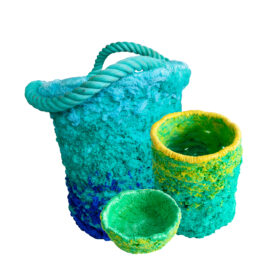Gundega Strauberga is a young artist from Latvia, where she studied sculpture and design. She then went on to Design Academy Eindhoven to practice a design thinking that goes beyond the physical function of an object. She likes to think that the value of her work lies in how it makes people feel.
What inspired you to create Beachcombers?
This project began a year ago, when I discovered the material during a workshop held by Envisions – a collective that believes in showcasing everything but the end product. The playful approach let me experiment freely, without having any goal or application in mind. One of the materials I explored during the workshop was polypropylene rope, the kind that is particularly suited for use around water, is resistant to mildew and will not rot or decay, therefore highly unsustainable. Commercial fishermen commonly utilize this rope. Having found out that more than 640.000 tonnes of nets and rope used in commercial fishing are dumped and discarded in the sea every year, which makes up the majority of large plastic pollution in the oceans, I knew I had to do something with it.
The time it takes me to process the material is immense, which is what inspired me to see it as a craft. I started devoting myself to it during the months we had to spend in lockdown. I imagined this would be something people who live near the sea would do all the time, passing the time by creating beautiful objects from the debris collected from the beach. I chose to make baskets because it is one of the oldest crafts of humankind and one of the most frequent handmade souvenir sold on the streets until this day. Beachcombing (strandjutten in Dutch) is a term to describe the scavenging of things washed up at shore. Beachcombers represent the future of crafted souvenirs, influenced by marine pollution.
How did you come across Healthy Seas?
My initial plan was to visit small fishing villages in the Netherlands and back home in Latvia, to meet people, talk about this problem and see if I can scavenge some material on the go. That was right before Covid hit Europe. Realizing that I was not going to be able to travel freely and meet people anymore, I started looking for different organizations and companies that are cleaning oceans, in hopes of getting access to some material. That’s how I found people from Ghost Diving, and Healthy Seas is one of their partners. I was lucky to find that the net collection point for Healthy Seas was in Den Oever, just a few hours drive away. As it is not my comfort zone and I prefer to work independently, it took extra effort for me to contact bigger organizations and ask for help. I would say that might have happened under the influence of Covid, when I recognized the need for expanding my network to make things work. After getting the material, collected by fishermen in Den Oever and provided by Healthy Seas, I was able to work at home, as the technique I am using is quite primitive and does not require any special tools.
What role does art have in society?
A crucial one… It holds the power to move and trigger people, make them see and discover. It makes us question the reality, how we live and why and how else could we do it. If you want society to listen, you have to inspire rather than criticize. I see a lot of examples where it has become tiring to listen to certain problems that we are facing, simply because the approach has been repeated many times or it is pointing fingers and nobody likes to be pointed at. Artists and designers are able to give a glimpse into alternative realities – doomed or desirable, they will remind the society that we are still free to make choices that affect our current and future lives.
What/who has been your biggest influence?
I am inspired by the mundane and daily. I don’t see a clear distinstion between beautiful and ugly. Everyone says they are inspired by nature, which already sounds like banality, but how can we not? We are nature. Lately a theme that has intervowen much of my work is human interference with it.
What are your plans for the future ?
For the Beachcombers project, my dream is to really work together with people who live in highly polluted areas, to make further basket collections together. This way it could become a platform where the craft is overtaken by others, altered and improved… And some of the income we could donate to organizations like Healthy Seas. The baskets are already available for purchase at Yksi Expo Eindhoven, where the project is currently on show, and on Rethinking-Plastic, which the Beachcombers have recently joined (for more information, Gundega can be reached at [email protected].)
I try to stay flexible and open-minded to any new projects, collaborations or jobs, anywhere in the world. I value team work and collaboration, because everyone is best at something different and this is where we can combine our strenghts and do tremendous things. I am not making any long-term plans at the moment, as life is unpredictable already as it is and especially in these times.
Gundega’s work has been part of various exhibitions over the last years, from predicting future crafts and geology by looking from the point of view of one material (the Beachcombers project, now part of the Rethinking Plastic collection, and The Cabinet of Anthropogenic Specimens, currently at Museo Nazionale Scienza e Tecnologia “Leonardo da Vinci” in Milan), to sci-fi speculative scenarios of buying body parts, inspired by the Frankenstein novel (Franky Tongues for museum TwentseWelle.
If you are an artist or student and need our input for your project, please contact [email protected]
Follow Gundega



